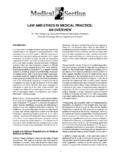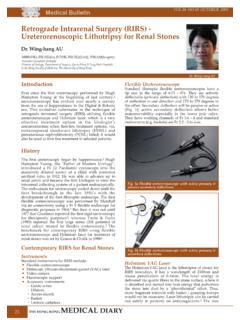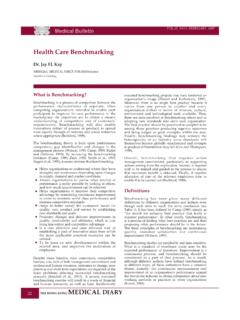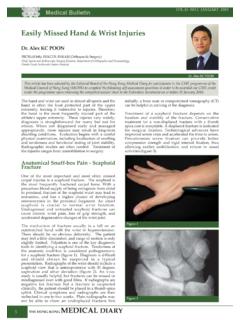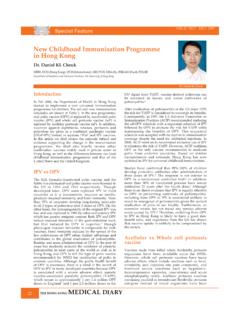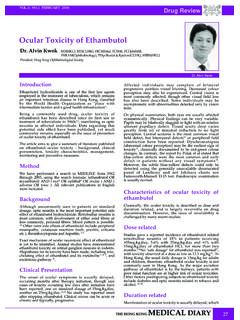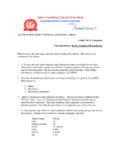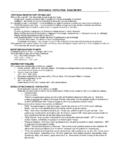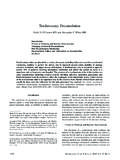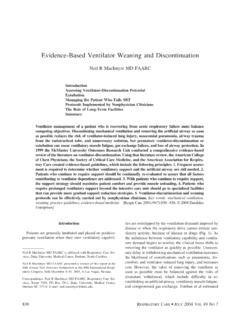Transcription of Management of Excessive Respiratory Secretions: A …
1 Palliative Medicine Doctors Meeting_____HKSPM Newsletter 2007 Dec Issue 3 p 16 Case histories contributed by Dr Ng Sheung Ching and Dr Ma Chi MingThe Story of Madam CMadam C, a 72-year old retired farmer, had been suffering from right biliary papillomatosis since 2003 with extended right hepatectomy performed. Extensive liver metastases were noted since 2006 and metastatic adenocarcinoma to left lung was detected in 2003. She refused chemotherapy and accepted palliative care. She complained of cough with profuse whitish mucoid sputum which had increased to over 300 ml per day.
2 Oral hyoscine methobromide had been tried with initial improvement. However, the disease progressed and the sputum volume increased to around one liter per day causing dyspnea even at rest. A clinical diagnosis of bronchorrhea was made. Various medications including oral erythromycin 500 mg twice daily and oral indomethacin 50 mg twice daily were tried with no improvement in bronchorrhea but were complicated by nausea with erythromycin and impaired renal function with indomethacin.
3 Continuous subcutaneous infusion of hyoscine hydrobromide up to mg per day was given with no improvement in sputum volume but resulted in Excessive drowsiness. Continuous subcutaneous infusion of fentanyl and midazolam was needed to control her dyspnea and restlessness. Subsequently, continuous subcutaneous infusion of octreotide was given at a dose of 200-300 micrograms per day. There was significant improvement in the volume of Respiratory secretions , dyspnea, and restlessness.
4 Subcutaneous hyoscine and midazolam infusions were stopped due to improvement in symptoms. Her alertness also improved. She subsequently died 10 days after commencement of octreotide infusion. The Story of Madam SMadam Sin, aged 48, was previously a trainer in a cosmetic and fitness center. She had a second marriage. She was diagnosed to have polymyositis in 1997 presenting with weakness. Multiple immunosuppressive therapies had been tried including glucocorticoids, azathioprine, cyclophosphamide, cyclosporin, intravenous immunoglobulins, mycophenolate mofetil, and rituximab, but her disease progressed.
5 She had an episode of severe pneumonia requiring intubation and subsequent tracheostomy. She was then transferred to the rehabilitation ward for convalescence. Upon admission, she was totally dependent in her daily living, and she needed non-oral feeding due to dysphagia. She was just able to move her eyes and fingers. Her main physical symptoms were Excessive saliva and sputum affecting her speech and eating, sense of suffocation due to secretions , pain and numbness over pressure points, and pain in multiple joints.
6 Concerning her psychological state, she had a strong sense of helplessness due to repeated treatment failures and loss of independence, fear of dying from suffocation, sense of loneliness due to infrequent visits from her family, and anger and frustration about her physical needs not being promptly addressed by staff. She frequently called for help with dramatic gestures and repeated call bells ringing. The multidisciplinary team attempted to address her multiple needs. The physiotherapist performed vigorous chest physiotherapy and hand function enhancement exercises; the occupational therapist designed a special chair and a foot platform to facilitate her sitting out; the speech therapist provided speech training; the clinical psychologist enhanced her self expression by drawing; the chaplain and some volunteers provided religious, spiritual and social support.
7 And the social worker assisted her in hiring a maid to take care of her in the Management of Excessive Respiratory secretions : A Sharing of Two Patients StoriesDr Lam Wai Man, Haven of Hope : Medicine Doctors Meeting_____HKSPM Newsletter 2007 Dec Issue 3 p 17and the nurses educated her on performing self suction of saliva. The doctor tried many medications to manage her saliva secretions including oral promethazine, oral amitriptyline, and inhaled ipratropium, but they were not injection of Botulinum toxin (Botox) 15 Units into each submandibular gland, was performed under ultrasound guidance.
8 It was effective in reducing the volume of saliva secretions by about 70% at one week after injection. The tracheostomy was successfully weaned off. She became less anxious, more talkative and expressive. She survived for six more months after Botox injection with no recurrence of Excessive salivation, and she died of acute myocardial infarction and hospital acquired Management of BronchorrheaBronchorrhea is arbitrarily defined as watery sputum production of over 100 ml per Up to 9 Liters per day has been It can be caused by primary lung malignancy especially of bronchioloalveolar cell type and metastases to lung especially from cells of glandular origin ( adenocarcinoma of cervix.)
9 Colonic adeno- carcinoma, and pancreatic cancer). 3, 4, 5 It can also be caused by non-malignant conditions like chronic bronchitis, asthma, and endobronchial are three postulated pathophysiological mechanisms for bronchorrhea: 1. Hyper-secretion of mucus-glycoprotein and other glandular products from mucus- glycoprotein producing cells neutrophils accumulating in airway mucosa may stimulate goblet cells Increased transepithelial chloride secretion- this can be mediated by receptors for prostaglandins (PGE2, PEF2 ) or secretin in the bronchial Excessive transudation of plasma products into the airway.
10 6 Bronchorrhea has negative impact on both survival and quality of life. It can cause Excessive cough, sleep disturbance and dyspnea. When severe, it may lead to Respiratory failure, dehydration and electrolyte disturbance. The Management of bronchorrhea includes general supportive measures to promote comfort, maintenance of fluid and electrolyte balance, and measures to reduce bronchial secretion production. The following seven entities have been tried in reducing bronchial Secretions: 1. Radiotherapy and traditional chemotherapy2.

